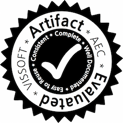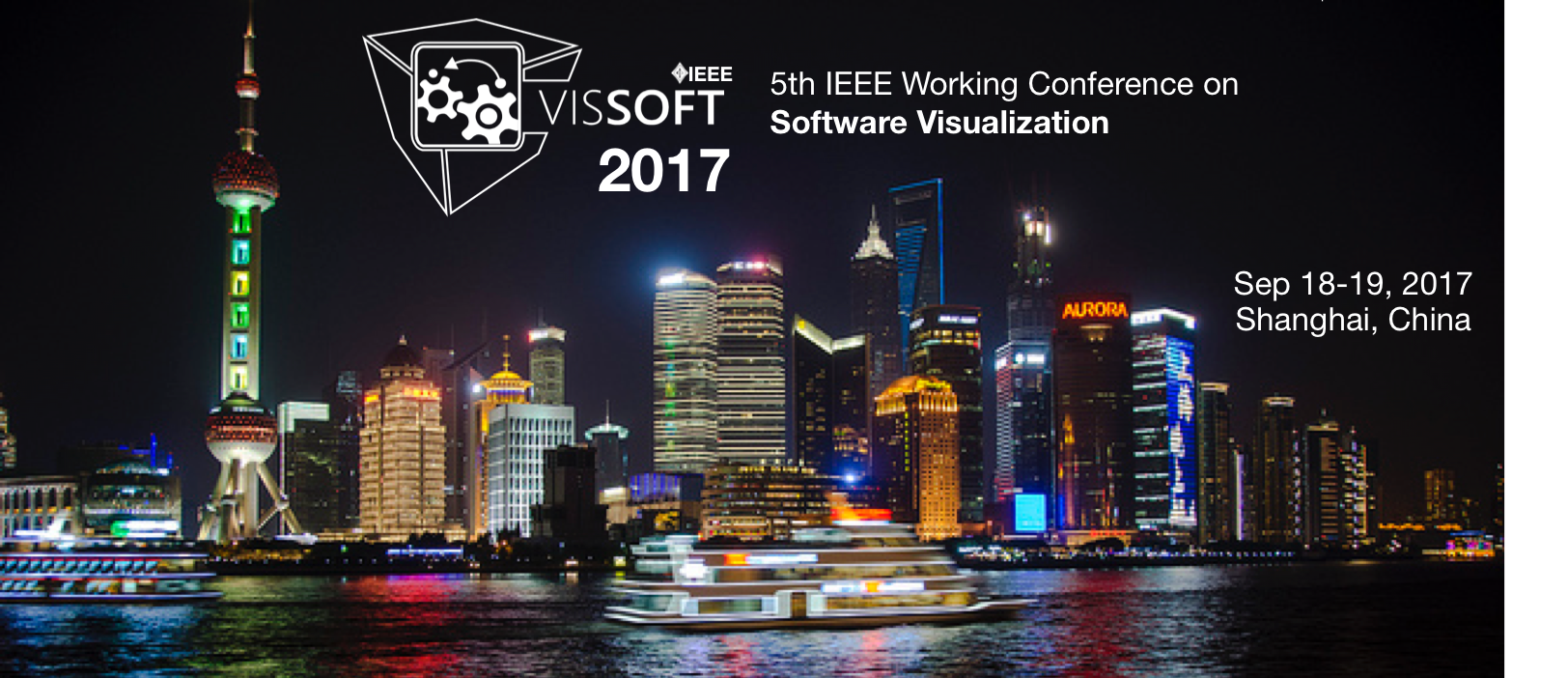Papers with accompanying artifacts are indicated with the artifact badge symbol.
Program: Monday, Tuesday
| 09:00 | Conference Opening | |||
| 09:15 | Keynote: Visualization in Code Bubbles: A Perspective and Look Ahead Steven Reiss | |||
| 10:30 | Coffe Break | |||
| 11:00 | Session 1: Comprehension Session chair: Andrea Mocci | |||
|
iTraceVis: Visualizing Eye Movement Data Within Eclipse. Benjamin Clark and Bonita Sharif preprint | FULL | |||
| An Empirical Study on the Readability of Regular Expressions: Textual versus Graphical. Niklas Hollmann and Stefan Hanenberg | FULL |  | ||
|
Syntactic Zoom-Out / Zoom-In Code with the Athenizer Plugin Yossi Gil, Dor Ma’ayan, Niv Shalmon, Raviv Rachmiel and Ori Roth. preprint | website | Tool | |||
|
A Conversational User Interface for Software Visualization Stefan Bieliauskas and Andreas Schreiber. website | Tool | |||
| 12:30 | Lunch | |||
| 13:30 | Session 2: Software Behavior and Process Session chair: Leonel Merino | |||
| Concept-Driven Generation of Intuitive Explanations of Program Execution for a Visual Tutor. Mohammad Reza Azadmanesh and Matthias Hauswirth | FULL |  | ||
| Method Execution Reports: Generating Text and Visualization to Describe Program Behavior. Fabian Beck, Hafiz Ammar Siddiqui, Alexandre Bergel and Daniel Weiskopf preprint | FULL | |||
|
A Dashboard for Visualizing Software Engineering Processes based on ESSENCE Sebastian Brandt, Michael Striewe, Fabian Beck and Michael Goedicke. preprint | website | Tool | |||
|
SoL Mantra: Visualizing Update Opportunities Based on Library Coexistence Boris Todorov, Raula Gaikovina Kula, Takashi Ishio and Katsuro Inoue preprint | Tool | |||
| 15:00 | Coffee Break | |||
| 15:30 | Session 3: 3D Visualization Session chair: Fabian Beck | |||
|
Using High-Rising Cities to Visualize Performance in Real-Time. Katsuya Ogami, Raula Gaikovina Kula, Hideaki Hata, Takashi Ishio and Kenichi Matsumoto preprint | artifact | FULL |  | ||
|
Code Park: A New 3D Code Visualization Tool. Pooya Khaloo, Mehran Maghoumi, Eugene Taranta Ii, David Bettner and Joseph Laviola Jr. preprint |
FULL | |||
|
On the Impact of the Medium in the Effectiveness of 3D Software Visualizations. Leonel Merino, Johannes Fuchs, Michael Hund, Craig Anslow, Mohammad Ghafari, Oscar Nierstrasz, Michael Behrisch and Daniel Keim preprint | artifact | FULL | |||
| Interactive Visualization of Software Components with Virtual Reality Headsets Andreas Schreiber and Marlene Brüggemann. | Tool | |||
|
Getaviz: Generating Structural, Behavioral, and Evolutionary Views of Software Systems for Empirical Evaluation David Baum, Jan Schilbach, Pascal Kovacs, Ulrich Eisenecker and Richard Müller. website | Tool | |||
| 18:00 | Leaving for VISSOFT Banquet | |||
| 09:15 | Keynote: Interactive Model Analysis Shixia Liu | ||
| 10:30 | Coffe Break | ||
| 11:00 | Session 4: Performance and Data Analysis Session chair: Raula Kula | ||
|
Visual Exploration of Memory Traces and Call Stacks. Patrick Gralka, Christoph Schulz, Guido Reina, Daniel Weiskopf and Thomas Ertl preprint | FULL | ||
| A Scalable Visualization for Dynamic Data in Software System Hierarchies. Michael Burch and Michael Raschke | FULL | ||
|
A Low-Effort Analytics Platform for Visualizing Evolving Flask-Based Python Web Services Patrick Vogel, Thijs Klooster, Vasilios Andrikopoulos, Mircea Lungu preprint | website | NIER | ||
| 12:30 | Lunch | ||
| 13:30 | Tool Demos | ||
| 15:00 | Coffee Break | ||
| 15:30 | Session 5: Software Process Session chair: Bonita Sharif | ||
|
Collaborative Modeling and Visualisation of Software Systems Using Multidimensional UML Matej Ferenc, Ivan Polasek and Juraj Vincur. preprint | website | NIER | ||
|
Towards the Visualization of Usage and Decision Knowledge in Continuous Software Engineering Jan Ole Johanssen, Anja Kleebaum, Bernd Bruegge and Barbara Paech. preprint | NIER | ||
|
Round-Trip Sketches: Supporting the Lifecycle of Software Development Sketches from Analog to Digital and Back Sebastian Baltes, Fabrice Hollerich and Stephan Diehl. preprint | website | NIER | ||
| 16:30 | Awards | ||
| 16:40 | Most Influential Paper: A task oriented view of software visualization | ||
| 17:30 | Open Steering Committee Election | ||
Keynote: Visualization in Code Bubbles: A Perspective and Look Ahead, Steven Reiss

Abstract. While on-line program visualization has been a research topic for over 30 years, today's environments seem to do very little program visualization. Over the past 8 years, we have been developing the Code Bubbles programming environment. In doing so, we have attempted to emphasize visualization while providing a real, large-scale, practical and useful programming environment. Some of the visualizations are obvious, what everyone would call a visualization. Others are more subtle, passing as simple highlighting or window layout. Others are text displays which are actually visualizations.
A recent addition to Code Bubbles is continuous execution. This facility lets the user choose a test case or stop at a breakpoint. It then computes the whole execution for the current method and updates the execution as the user edits. This facility requires the ability to display the complete execution of a method as well as means for navigating within the execution. Both of these are accomplished through visualizations.
This talk will look at the various visualizations, provide a (biased) historic perspective on where they came from, and provide a (hopefully) realistic assessment of their value. In doing this we will concentrate on specific problems that visualization can address, particularly in understanding the execution dynamics of a complex system.
Bio. Steven Reiss is Professor of Computer Science in the Computer Science Department at Brown University. He has been a member of the Brown faculty since 1977. He is the author of numerous papers in journals and proceedings, as well as two books. He has served on a variety of conference program committees for SIGPLAN, SIGSOFT, and IEEE. He has written several software systems that have been widely distributed outside of Brown.
Dr. Reiss's research interests and expertise center around programming, in particular making programming simpler and more understandable. He has done extensive research in the areas of programming tools and environments as well as program visualization. He has also done work on message-based integration, program design, databases, and the debugging, testing and checking of complex systems.
Current research by Dr. Reiss includes Code Bubbles, a working-set based programming environment that includes the use of intelligent features and visualizations to assist the programmer; semiautomatic automatic bug repair; and semantic-based code search for methods, classes, user interfaces and system frameworks. For more information look at http://www.cs.brown.edu/people/spr/.
Keynote: Interactive Model Analysis, Shixia Liu

Abstract. In most AI applications, machine learning models are often treated as a black box. Users usually refine and improve the models according to performance metrics such as accuracy. Because of lacking of a comprehensive understanding of the working mechanism of these models, it is hard to build an effective two-communication between a human anda computer, which limits the further adoption of the models. To solve this problem, we have developed a set of visual analytics approaches to help users understand, diagnose, and refine a machine learning model. This talk presents the major challenges of interactive machine learning and exemplifies the solutions with several visual analytics techniques and examples. In particular, we mainly focus on introducing the following three aspects: 1) create a suite of machine learning techniques that produce more explainable models, while maintaining a high level of learning performance (prediction accuracy); 2) develop a set of visual analytics techniques that enable human users to understand and diagnose machine learning models; 3) a semi-supervised model refinement mechanism. Based on these, we develop an interactive model analysis framework, which is exemplified by deep learning,ensemble learning, and the topic model.
Bio. Shixia Liu is an associate professor at Tsinghua University. Her research interests include visual text analytics, visual social analytics, visual behavior analytics, graph visualization, and tree visualization. Before joining Tsinghua University, she worked as a lead researcher at Microsoft Research Asia and a research staff member at IBM China Research Lab. Shixia is one of the Papers Co-Chairs of IEEE VAST 2016 and 2017. She is an associate of IEEE Transactions on Visualization and Computer Graphics and is on the editorial board of Information Visualization. She was the guest editor of ACM Transactions on Intelligent Systems and Technology and Tsinghua Science and Technology. She was the program co-chair of PacifcVis 2014 and VINCI 2012. Shixia was in the Steering Committee of VINCI 2013. She is on the organizing committee of IEEE VIS 2015 and 2014. She is/was in the Program Committee for CHI 2018, InfoVis 2015, 2014, VAST 2015, 2014, KDD 2015, 2014, 2013, ACM Multimedia 2009, SDM 2008, ACM IUI 2011, 2009, PacificVis 2008, 2009, 2010, 2011, PAKDD 2013, VISAPP 2012, 2011, VINCI 2011.
Most Influential Paper Award: A task oriented view of software visualization, J. I. Maletic, A. Marcus and M. L. Collard



Abstract. A number of taxonomies to classify and categorize software visualization systems have been proposed in the past. Most notable are those presented by Price (1993) and Roman (1993). While these taxonomies are an accurate representation of software visualization issues, they are somewhat skewed with respect to current research areas on software visualization. We revisit this important work and propose a number of re-alignments with respect to addressing the software engineering tasks of large-scale development and maintenance. We propose a framework to emphasize the general tasks of understanding and analysis during development and maintenance of large-scale software systems. Five dimensions relating to the what, where, how, who, and why of software visualization make up this framework. The focus of this work is not so much as to classify software visualization system, but to point out the need for matching the method with the task. Finally, a number of software visualization systems are examined under our framework to highlight the particular problems each addresses.
VISSOFT Banquet - Monday, September 18, 2017 - 18:30
Shanghai WH Ming Hotel 小南国花园酒店(黄兴公园店)
(Chinese Food)
Last bus leaves at 18:00 from Crowne Plaza


